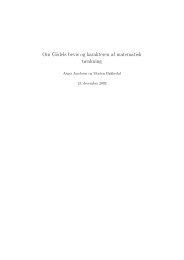Master Dissertation
Master Dissertation
Master Dissertation
Create successful ePaper yourself
Turn your PDF publications into a flip-book with our unique Google optimized e-Paper software.
Thus<br />
n−1 <br />
|<br />
j=0<br />
〈φ(x)d(x), ψ1(a j x/δ)ψ0(a j n−1<br />
x/δ)〉| ≤<br />
But ρ(δ) → ∞ Hence the convergence is uniform.<br />
We now prove the theorem.<br />
<br />
K/ρ(δ/a j )<br />
j=0<br />
≤ Kρ(δ) −1<br />
∞<br />
j=0<br />
a jω<br />
1<br />
= Kρ(δ) −1 (1 − a ω 1 ) −1 .<br />
Proof of Theorem 7.7. Another way to state the theorem is that the<br />
limit in (7.11) exists for all sequences δn → 0. This is done by showing<br />
〈χ0( v·x)d(x),<br />
φ(x)〉 is a Cauchy sequence. Consider<br />
δn<br />
v · x v · x<br />
v · x v · x<br />
χ0( ) − χ0( ) = χ0(an,m ) − χ0( ), (7.15)<br />
δm<br />
δn<br />
where an,m = δn/δm. Assuming δm < δn, we know from Lemma 7.8 that<br />
for all φ and for all ɛ > 0 there exists some δ0 > 0 such that for all δ < δ0<br />
|〈(χ0(an,m<br />
v · x<br />
δ<br />
δn<br />
δn<br />
v · x<br />
) − χ0( ))d(x), φ(x)〉| < ɛ<br />
δ<br />
Hence given φ and ɛ > 0 we may choose δ0 and N such that δn < δ0 for all<br />
n, m ≥ N<br />
v · x v · x<br />
|〈(χ0( ) − χ0( ))d(x), φ(x)〉| < ɛ.<br />
δm<br />
δn<br />
Hence 〈χ0( v·x)d(x),<br />
φ(x)〉 is a Cauchy sequence.<br />
δn<br />
Now suppose δn and δn ′ are two sequences converging towards 0. Then as<br />
above, with an,n ′ = δn ′/δn in (7.15),<br />
v · x<br />
v · x<br />
〈χ0( )d(x), φ(x)〉 − 〈χ0( )d(x), φ(x)〉 → 0<br />
δn<br />
as n → ∞. Hence the limit exists.<br />
Now we may define<br />
Definition 7.9.<br />
δn ′<br />
v · x<br />
r(x) = lim χ0( )d(x) = θ(v · x)d(x).<br />
δ→0 δ<br />
Similarly there exists an advanced distribution.<br />
57



